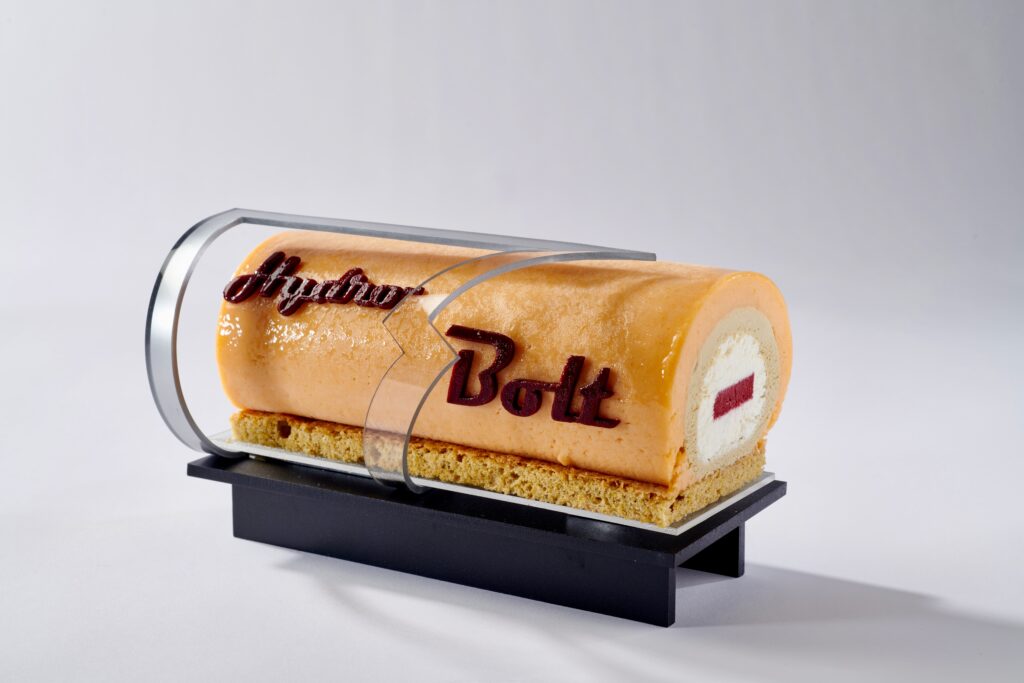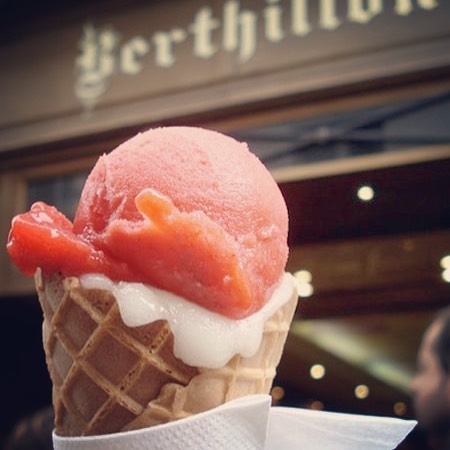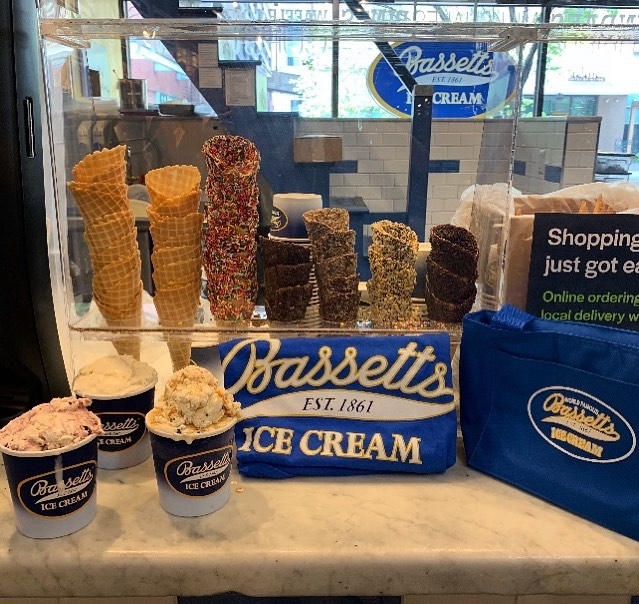July is a month packed with celebrations like Independence Day, Bastille Day, and National Milk Chocolate Day. But amidst all the festivities, there’s one celebration that has us jumping with joy throughout the entire month — National Ice Cream Month!
As we celebrate National Ice Cream Month, let’s take a look at the history of this sweet treat.
What is Ice Cream?
By definition, ice cream is a frozen dessert typically made from milk or cream that has been flavored with a sweetener, either sugar or an alternative, and, spice, fruit, or other ingredients. In the United States, the frozen dessert cannot be called ice cream if it contains anything with less than 10% milkfat and/or more than 100% overrun.

While defining ice cream is a straightforward task, tracing its intricate history can be quite a complex endeavor. Over the centuries, this beloved frozen dessert has evolved through the contributions of different cultures and regions, making its historical path captivating and intriguing to explore.
Early Frozen Desserts
The origins of frozen desserts remain shrouded in mystery, but various accounts shed light on their history.
According to food writer and historian, Tori Avey, there have been several myths and tales about the birth of ice cream including one suggesting that Marco Polo discovered it during his travels in the Far East and brought it back to Europe. Another romanticized account claims that Catherine de Medici introduced ice cream to France when she married King Henry II. She says that although both of these stories are “romantic” they are unlikely true. However, the International Dairy Foods Association presents a different perspective on the matter.
“Over a thousand years later, Marco Polo returned to Italy from the Far East with a recipe that closely resembled what is now called sherbet,” states the website. “Historians estimate that this recipe evolved into ice cream sometime in the 16th century.”
Ice cream-like treats have been traced back to ancient Persia as far back as 550 BC, according to various sources. The Persians ingeniously utilized ice houses and ice pools to master the craft of producing and serving delectable delights such as faloodeh and sorbets year-round.
Dr. Keveh Farrokh writes it is believed that “Arabs who had conquered [the] Persian Empire at the time took the age-old Persian refreshment called Sharbat and enriched the existing mix of fruit syrup and snow chilled honey with milk and sugar. This was the conception of the modern-day granita and gelato.”
“Biblical passages refer to King Solomon enjoying cooling iced drinks during harvest season. Alexander the Great of ancient Greece loved to indulge in icy drinks flavored with honey or wine,” writes Avey. “During Nero’s reign of Rome from 54-68 BC, ice was harvested from nearby mountains and held in ice houses deep pits covered with straw. This practice of keeping ice in lieu of refrigeration would be common for centuries to come.”
Farrokh writes that Persia (modern-day Iran) has a remarkable history of making ice cream that spans over 2,000 years. The inspiration for the design of ice cream is believed to have come from a cone-shaped structure called Yakchal, found in the region. As early as 400 BC, Persians utilized the underground space of Yakchal for storing ice cream, taking advantage of the structure’s heat-resistant materials that helped preserve this delicious treat in the scorching climate.
At some point, it is believed that the process and recipe for making the Persian Faloodeh ice cream then traveled to Italy, which made machines to make ice cream making easier.
These early innovations, although far different from what we recognize today as ice cream, marked the beginning of a frozen dessert legacy that continues to enchant taste buds to this day.
Tang dynasty records mention a chilled dessert made with flour, camphor, and water buffalo milk. Kakigori, a Japanese dessert, originated during the Heian period when blocks of ice were shaved and served with sweet syrup to the Japanese aristocracy. The earliest known written process to artificially make ice dates back to the 13th century, as described by Arab historian Ibn Abi Usaybi’a. Ice cream production became easier with the discovery of the endothermic effect, where the addition of salt lowered the melting point of ice, enabling cream to freeze.
Interestingly, it appears that England may have discovered ice cream around the same time or even earlier than the Italians. Referred to as ‘Cream Ice,’ this delightful treat made frequent appearances on the table of Charles I during the 17th century.
England
Wikipedia gives other examples of where references to ice cream and flavored ices appear in print:
Ice cream made its first recorded appearance in England in 1671 when Elias Ashmole described a dish of ice cream served at the Feast of St George in Windsor for Charles II. Interestingly, the only table with ice cream was that of the King. The first published recipe for ice cream in English came later in 1718, in a book called “Mrs. Mary Eales’s Receipts,” dedicated to confectionery, in London.
The 1751 edition of The Art of Cookery made Plain and Easy by Hannah Glasse includes a recipe for ice cream: “H. GLASSE Art of Cookery (ed. 4) 333 (heading) To make Ice Cream..set it [sc. the cream] into the larger Bason. Fill it with Ice, and a Handful of Salt.”
The year 1768 saw the publication of L’Art de Bien Faire les Glaces d’Office by M. Emy, a cookbook devoted entirely to recipes for flavored ices and ice cream.
In 1769 Domenico Negri, an Italian confectioner, founded a business in Berkeley Square London which would become famous for its ice creams. His shop was at the Sign of the Pineapple (an emblem used by confectioners) and his trade card said he sold:
‘All Sorts of English, French and Italian wet and dry’d Sweet Meats, Cedrati and Bergamot Chips, Naples Diavoloni, All sorts of Baskets & Cakes, fine and Common Sugar plums…’ but most importantly ‘…all Sorts of Ice, Fruits and creams in the best Italian manner.’
In 1789 Frederick Nutt, who served an apprenticeship at Negri’s establishment, first published The Complete Confectioner. The book had thirty-one different recipes for ice creams, some with fresh fruit, others with jams, and some using fruit syrups. Flavors included ginger, chocolate, brown breadcrumbs, and one flavored with Parmesan cheese.
France
France was introduced to similar frozen desserts in 1553 by the Italian Catherine de Medici when she became the wife of Henry II of France,” states the International Dairy Foods Association. “It wasn’t until 1660 that ice cream was made available to the general public. The Sicilian Procopio introduced a recipe blending milk, cream, butter, and eggs at Café Procope, the first café in Paris.”
As early as 1665, a catalogue called “Catalogue des Marchandises rares” edited by Jean Fargeon in Montpellier listed a frozen sorbet, consumed by plunging a container into a mixture of ice and saltpetre. The practice of cooling beverages with ice and snow emerged in Paris during the 16th century and progressed over time. In 1682, a recipe for a specific type of ice cream called “neige de fleur d’orange” appeared. Francesco dei Coltelli opened the first ice cream café in Paris in 1686, leading to the opening of numerous cafés in the following years. The first French recipe for flavored ices appeared in 1674, followed by recipes in 1694 and 1692 by Antonio Latini and François Massialot, respectively, each with their own desired texture for the final product.

Among the many notable distinctions in Paris, Raimo holds the title of the oldest ice cream parlor in the city, having been established in 1947. It is revered as a traditional and historical ice cream parlor. However, when it comes to popular recognition among both Parisians and visitors, Berthillon takes the spotlight. Berthillon, which opened in 1954 on Ile Saint Louis, is widely regarded as the go-to destination for exquisite ice cream in Paris.
America

The first documented mention of ice cream in the New World dates back to a letter written in 1744 by a guest of Maryland Governor William Bladen. The earliest advertisement for ice cream in the United States appeared in the New York Gazette on May 12, 1777, announcing its availability “almost every day” by confectioner Philip Lenzi. Records indicate that President George Washington spent around $200 (worth around $6,594.87 in today’s money) on ice cream during the summer of 1790, as noted by a New York merchant. President Thomas Jefferson had a favorite 18-step recipe for an ice cream treat resembling a modern-day Baked Alaska. The Library of Congress also has his recipe for vanilla ice cream in their archives. Dolley Madison served a splendid strawberry ice cream creation at President Madison’s second inaugural banquet at the White House in 1813.
The world of frozen delights underwent a significant transformation around 1800. Until then, ice cream had been a rare and luxurious dessert reserved for the privileged few. However, the invention of insulated ice houses marked a turning point. This breakthrough led to the rise of ice cream as a thriving industry in America. Jacob Fussell, a Baltimore milk dealer, played a pioneering role in 1851 by venturing into mass ice cream production.
As with other industries in America, ice cream production experienced remarkable growth due to technological advancements. Innovations such as steam power, mechanical refrigeration, the homogenizer, electric power, packing machines, and new freezing processes and equipment revolutionized the way ice cream was made. The introduction of motorized delivery vehicles further transformed the industry, making ice cream more accessible to a wider audience. This era of progress propelled ice cream from a rare delicacy to a beloved treat enjoyed by many.
The late 19th century witnessed the widespread availability of ice cream, which sparked the creation of new treats. In 1874, the American soda fountain shop and the iconic “soda jerk” profession emerged with the invention of the ice cream soda. To address religious criticism for indulging in ice cream sodas on Sundays, merchants omitted the carbonated water and introduced the ice cream “Sunday” in the late 1890s. Over time, the name was changed to “sundae” to dissociate it from any connection to the Sabbath.
Soft-serve ice cream, a creation of the United States, made its debut on the market in the 1930s.
During World War II, ice cream became a symbolic morale booster. Each branch of the military competed to serve ice cream to its troops in inventive ways. In 1945, the first “floating ice cream parlor” was constructed to cater to sailors in the western Pacific. As the war concluded and rationing on dairy products ended, the United States celebrated its victory with ice cream, marking a sweet tribute to the triumph.
From the 1940s to the ’70s, ice cream production in the United States remained steady. However, the rise of prepackaged ice cream in supermarkets led to the decline of traditional ice cream parlors and soda fountains. In their place, specialty ice cream stores and unique restaurants dedicated to crafting delightful ice cream dishes have gained immense popularity. These establishments appeal to both nostalgic individuals who reminisce about the ice cream shops and soda fountains of yesteryears, as well as to new generations of enthusiastic ice cream enthusiasts.

The oldest ice cream maker and parlor in America is Bassets in Philadelphia. Quaker school teacher and farmer, Lewis Dubois Bassett started making ice cream in his backyard with a mule-powered butter churn in 1861. He started selling his ice cream in 1885 at a 5th and Market Street location before moving to the Reading Terminal Market in 1892. Today, the company remains under the ownership and operation of the founder’s great-great grandsons.
Offering 40 ice cream, sorbet, and frozen yogurt flavors, Bassetts’s most popular flavors are vanilla, cookies & cream, and mint chocolate chip.
Although history cannot agree exactly when ice cream first appeared and who invented it, one thing it does agree on is that it is delicious and universally loved.
Sources:
Wikipedia
The Unknown Origins of Ice Cream in Ancient Iran, Farrokh, Dr. Kaveh
Explore The Delicious History of Ice Cream, PBS The History Kitchen, Avey, Tori; 10 July 2012
International Dairy Food Association